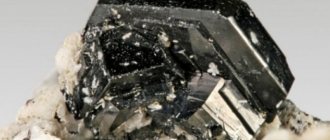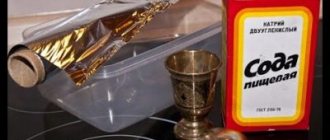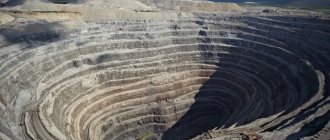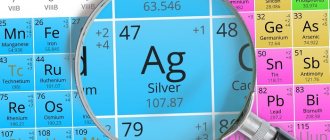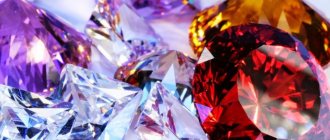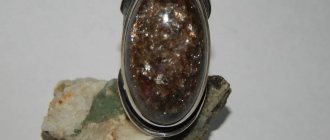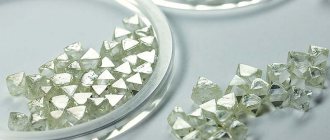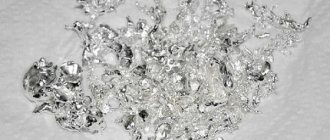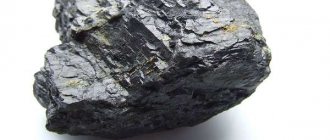The production of precious metals in the world is gaining momentum.
As of 2014, the amount of ore mined increased by 20% to 819 million troy ounces. Researchers at The Silver Institute concluded that at the beginning of the 21st century, the amount of extracted resources increased almost 3 times. Mexico is home to the largest precious metal mining centers in the world. Below Mexico, in terms of the amount of ore mined, are:
- China (3800 tons per year);
- Peru (3,700 tons per year);
- Australia (1900 tons per year);
- Russia (1800 tons per year).
Silver in nature
This is what the ore from which silver is mined looks like.
The main share of nuggets is extracted from polymetallic ores, where it is concentrated in the form of sulfide impurities. As for nuggets, they are rare. Their main share is mined from silver ores.
Nuggets of the precious metal are rare due to the tendency of silver to oxidize and form a black coating on it - aconite. In addition, it reacts with AgCl (chlorogarite) and ClBr (embolite), as a result of which it changes its structure and is sprayed into adjacent metals.
Food supplement
Today, silver is sometimes used in the food industry, where it is better known as additive E174. It is used to decorate confectionery products, but only in minimal quantities.
Advertising - Continued below
By the way, it is also present in natural products, for example, there is a lot of it in ordinary egg yolk. However, gold can also be edible and is popular as an ingredient in luxury dishes and desserts.
Scope of application of precious metal
The world's need for the resource is constantly growing, this is due to the fact that the mineral is used in many areas of industry: about 80% of silver bars are used in the production of equipment, mobile devices, computers, batteries and other modern equipment.
All modern microchips contain precious metals, including silver
If previously silver was used only for aesthetic purposes, today it is mainly used for industrial purposes. It is valued for its high conductivity of heat and electricity. In addition, the mineral cannot be oxidized and has good catalytic properties.
Residues from the industry are used in jewelry and for the production of precious coins. The intensive pace of production has led to the fact that there are almost no resource reserves left. Experts believe that they could be depleted in the next 20 to 30 years at this rate of production. At this point, humanity has depleted about 95% of all silver reserves on the planet.
Ancient healer
Since ancient times, the noble metal has been used in medicine. Even in Ancient Egypt, thin sheets of silver were applied to the wounds of patients so that they would heal faster.
Advertising - Continued below
And in Switzerland, toothache was treated with silver. To do this, the patient was given a coin, he applied it to the sore tooth and after a while the pain subsided.
Silver mining methods
Throughout human history, mining methods have changed. At first, the precious metal was extracted using an open method, but with the improvement of technology, they switched to a closed method. At the present stage, the resource is extracted in two ways - cyanidation and amalgamation.
- Cyanidation is the extraction of metal using an aqueous solution. The alloys are placed in a special solution consisting of cyanide and oxygen. The mineral is extracted from solution after filtering waste rocks. The resulting impurities on the metal are removed with sulfuric acid. The remaining solids are filtered, washed, evaporated and sent to the production of ingots.
Material balance of gold and silver for the technological scheme of ore processing by cyanidation - Amalgamation is an old method that humanity has been using to extract silver for more than 2 thousand years. The silver ore is passed through an amalgamated surface coated with mercury along with water. Particles of the precious metal enter into a chemical reaction with mercury, forming an amalgam - solid formations. The filtration method is applied to the solidified formations, extracting silver ore from it.
Amalgamation of silver is impossible without mercury, so this method is not used so actively.
The described methods cannot produce absolutely pure silver. It is extracted at refineries using the method of cleaning, filtration and secondary processing.
The progenitor of the ruble
Before the development of various industries (electrical engineering, photography, radio engineering) in which silver is used today, it was used primarily for the manufacture of dishes, jewelry and money.
Thus, in Rus', oblong silver bars acted as currency. They were cut down if some item was worth less than the entire ingot. Such money was called rubles. This name for Russian money has survived to this day.
Mexican mines are the richest deposits in the world
The largest mines in Mexico
Mexico is the world leader in the amount of silver ore and other precious metals mined. On the territory of this state, experts have recorded more than 200 mines where the precious resource is extracted.
Las Torres contains the largest deposits of silver in Mexico. Experts estimate its reserves at 4.3 million tons. The concentration of silver in this region reaches 280 g/t.
The second place in terms of the scale of extracted resources is occupied by the mines of La Encantada, Coahuila state. The total deposit savings amount to about 3.2 million tons of ore.
Relatively large areas of resource extraction are considered to be mines in the states of Hidalgo, Zacatecas and Chihuahua. On the territory of these states there are about 48 small deposits of silver ore, where about 20% of the total volume of mined resource in the state is mined.
It is worth noting that experts noticed a slight decline in exports of the precious metal in Mexico. For the first time in history, the amount of silver mined in the country decreased by 6% as of March 2016. Experts predict a slight decline in production for 2016-2017.
Process of extraction of natural raw materials
There are different ways to obtain silver:
- mine;
- career;
- borehole;
- nautical.
Of all the methods, only the quarry method involves the need to perform surface work. A less common marine option is when silver precious metal is mined below the seabed.
The average amount of silver in various rocks can reach 1 g/t, more than gold or platinum. Sea water contains up to 0.00004 g/t.
Study of the site
Using special equipment, as well as by inspecting the area, studying the structure, composition and properties of the ore, traces of the presence of precious metal are discovered. In open areas it is difficult to find silver inclusions, because the material is covered with a layer of silver sulfide or iron hydroxide, and oxides of other substances. This is the task of geologists; specialists draw up maps on which all deposits are marked.
Mine development
The technology for extracting precious metals is based on crushing rock by explosion. Crushing should be carried out in a limited area and at a certain depth. To do this, specialists place explosives inside the prepared holes. At the next stage of extraction, TNT blocks are laid.
Main silver deposits in Russia
In 1704, the mineral was mined at the state level at the Nerchinsky mines near Lake Baikal in Russia. The government and industrialists made no attempt to discover new deposits until the mid-20th century. During the Second World War and during the Cold War, the development of deposits in the Far East began. Russia ranks first in terms of silver reserves in the world. Almost 10.5% of world savings are concentrated on its territory. The main deposits are located in the Far East, Eastern Siberia and the Southern Urals.
Silver mining in Russia
It is worth noting that Russia does not have such rich deposits of the precious metal as in Canada, Germany or Norway, however, in terms of silver concentration, the Russian Federation surpasses all countries in the world.
Today, silver mining in Russia is carried out in 20 regions in more than 100 deposits. The proportion of silver in the main mines rarely exceeds 100 grams/t. The Dukat deposit (Magadan region) ranks first in the Russian Federation in terms of the number of reserves and the volume of silver production. In second place are the Lunnoe and Juliet deposits of silver deposits in the Magadan region. From these three centers, more than 30% of all silver is mined in Russia. Slightly less is mined in the Urals - about 20%. In third place are the Norilsk and Khakanja deposits, where about 7-10% of the precious metal is excavated.
Silver: silver mining and production
Rare nuggets. Connections with silver
Most often, the precious metal is found in polymetallic deposits, where it is contained in the structure of another ore. However, sometimes quite large Ag formations are found. The most famous of them:
- a nugget weighing 20 tons was discovered on the territory of the Schneeberg deposit, near the city of Freiberg;
- Konsberg mine (Norway): a nugget weighing 254 kg was found, it is in the Copenhagen Museum;
- Canada: a silver plate weighing 612 kg, an even larger formation known as the “silver pavement” was found here, has a length of 30 m, weighs 20 tons.
Silver Nuggets
Given that nuggets are rare, polymetallic ore is often mined. Common Ag-based compounds:
- contains sulfur (argentite);
- gold (electrum);
- lead (galena);
- arsenic (proustite);
- antimony (pyrargyrite).
Silver mining industry in the DPRK
The amount of precious metal mined in China fully meets the state’s needs for the resource. The rest is exported to Japan, Korea, Mongolia, Iran and other countries of the world. About 9.6% of the world's silver reserves are concentrated in China. It is found in lead-zinc and copper deposits.
Transportation of soil saturated with silver ore
Main centers of ore mining: Ying region. In this area, precious metal began to be mined in the late Middle Ages. The Ying region holds the record for silver ore in China. It concentrates about 15 million tons, which is almost 35% of the state’s reserves.
The southeastern regions of China are in second place in terms of the amount of silver ore reserves. The Fuwan field in Guangdong Province stands out in this region. Here ore is mined using a closed method. Experts estimate the deposit's reserves at 9 million tons. It is worth noting that Fuwan is one of the most profitable mines, since the concentration of silver in it reaches 190 g/t.
Thus, the territory of China is a promising place for silver mining. According to data, as of 2015, China ranks second in silver production in the world. Experts predict that China will take first place by 2018-2019 if production rates do not decrease.
Silver production
Ore extraction
The resulting precious metal cannot be used on the territory of the Russian Federation and throughout the world without additional processing. Most often, material purification is ensured by chemistry - a reaction with other compounds. The temperature method is also used. The main goal is the transformation of materials, which allows you to change the formula of Argentum and isolate it from the rock.
Writer Vitaly Rekhlov contributed to clarifying the story. He disseminated information about the true discoverer of Kuznetsk coal in Russia. He was a certain Mikhailo Volkov, an ore explorer who went in search of silver ore along with most of his comrades, which was facilitated by the decree of Peter I “on the search and extraction of valuable metals.”
Ore cyanidation
Short description:
- Dissolution, for which cyanide alkali is used.
- Filtration.
- Introduction of zinc powder.
- Melting after mining. The solid precipitate consists of silver particles. Under the influence of high temperature, a melt is obtained, which is sent to the plant for purification.
Silver deposits
Amalgamation with mercury
The metal is passed through a mercury solution and is pre-crushed. As a result, the material changes shape and becomes fluid. The resulting mass undergoes a spinning procedure. The mercury is separated, leaving a solid residue, which is melted to obtain working material and further purification.
Silver mining in Peru
The mining industry in Peru is considered one of the most developed in the country. Experts note that Peru produces about 17% of the world's silver ore reserves. According to data, as of 2015, there are about 784 mines operating in the state. Mines with a total reserve of more than 120 thousand tons remain unopened and unprocessed.
Silver production ramps up in China and Peru
Industrial extraction of the precious resource in the country began in 1991, when the government lifted restrictions on the extraction of the country's national wealth. It is worth noting that almost 75% of all mines belong to foreign investors and their capital.
The largest deposits in Peru are concentrated in San Rafael (Eastern Cordillera). Almost 27% of the country's total reserves are located here. It is worth noting that San Rafael contains the richest reserves with a high concentration of silver up to 230 g/t.
Second place is occupied by 4 mines located in Hulkani, San Cristobal, Gulkenia and Morococha. They account for about 14% of the country's total reserves. The extraction of silver ore in these areas is carried out using a closed method.
The country is considered one of the wealthiest in the world. Remains from industry are exported to neighboring countries. Peru has the closest trade relations with European countries. They supply about 80% of all silver for export.
Wide application of silver alloy
The purity of the material may vary, depending on many factors, including the area of use of the silver product:
- jewelry production: about 20% of argentum is sent to factories for the manufacture of jewelry and accessories, which can then be purchased in jewelry and online stores; this alloy contains copper or platinum to improve the properties and make the metal attractive;
- medicine, dentistry: argentum is widely used to coat various products, is included in preparations, and is used in dentistry (silvering, prosthetics) due to its antibacterial properties;
- industry: Ag is used in the production of batteries, radio components, contact parts of mechanisms;
- glass production: the silvering method is used, as a result, a variety of reflective surfaces are obtained;
- defense industry, for example, Ag contain elements of gas masks;
- computer and electrical engineering: the main one is the production of contact material, parts for the production of microcircuits;
- forensics: traces of a criminal are detected using silver nitrate, which makes it possible to identify sweat-fat substances on surfaces.
Australian mining industry
The island nation ranks fourth in the world in terms of the amount of silver mined. Last year, local entrepreneurs produced almost 55.4 million ounces of this resource. It is worth noting that in Australia the mining industry is developing at a fairly rapid pace. The first mine was built by local residents in 1840 in Tasmania (Reed-Rosbury). The valuable resource was mined using a closed method from lead, zinc and gold.
The main deposits are concentrated in the southwest of the mainland - in the state of Western Australia. The largest mines are located near the cities of Kalgoorlie
BHP Billiton is a leading silver and lead mining company in Kirrington, western Queensland. In 2015, the company received approximately 32.12 million ounces of the resource. Currently, BHP Billiton mines and produces about 43% of the resources in the entire territory of Australia.
The second large mine is considered to be Mt. Isa in Queensland. Here, mining companies extract deposits of silver ore using a closed method. The Mac Arthur River mine is the third most important. It produces about 15% of all Australian iron.
It is also worth noting the giant companies Xstrata ADR and Minmetals Recources. They own small deposits in the western lands (South Wales and Broken Hill).
Metal cleaning
- The ore is placed in a tank and treated with zinc dust. As a result, all impurities settle to the bottom, while the target raw material remains at the top. Subsequent cleaning is carried out in factories.
- The pyrometallurgical method produces pure silver. Copper or lead should be used as concentrators. These substances are treated with zinc at a temperature of 450 degrees - this way the metal particles dissolve better. After extracting the frozen substance, the precious metal is separated from it.
- At 1250 degrees, the zinc evaporates, but the remaining silver still contains arsenic and lead. For cleaning, oxygen treatment and heat exposure of 1000 degrees are used. This method is the most profitable, since lead and copper are mined in large quantities. Recycling such elements does not require significant costs.
- The purified precious metal is melted into ingots. No technology can guarantee 100% pure silver. To completely get rid of impurities, the ingots are transported to metallurgical plants for further processing.
If copper or lead is used as the main raw material, a pyrometallurgical purification technique is used. This method is advantageous because these impurities are inexpensive. As a result, the cost of the production process decreases, and the costs of producing less expensive metals are recouped. Electrochemical purification technology is used to separate silver.
What things and materials can you get silver from?
Precious metal is found in many objects around us. There is especially a lot of it in old things made back in the USSR: tableware, as well as trays and candelabra, Soviet awards, glass Christmas tree decorations of that time, photographic plates and other photographic items.
From radio components and circuits
Soviet-made radio components and circuits are rich in silver, especially in relays and microswitches. From them alone, up to 2-3 grams of high-purity metal can be isolated.
More ways
Nowadays, silver is mined not only in mountain deposits, but also in urban areas. There are large industrial enterprises specializing in the secondary processing of the photosensitive emulsion layer of photographic materials and x-rays.
From the associated effluents of this process, silver is captured in volumes comparable to its extraction from a profitable mine. This way, metal that has already been used once gets a second life.
Pros and cons of mining at home
Extracting metal at home always has a certain degree of risk (working with acids, for example). From the point of view of material enrichment, we must admit: this is not economically profitable, since it is time-consuming and requires a certain amount of reagents, equipment and knowledge.
The main advantage: a high-quality product - silver, the purity of which no manufacturer can guarantee you.
Historical reference
People have been familiar with silver since ancient times, as it was a popular nugget and did not require smelting ore. The oldest centers of metal mining and processing include prehistoric Sardinia, where it became known in the early Chalcolithic period.
Silver includes archaeological finds on different continents. Accessories dating back to 5.5–7 millennia were found on the territory of Ancient Egypt. The metal was then obtained from ancient deposits in Syria.
Since ancient times, the element has been assigned magical and healing properties. Because of this, it was associated with the Moon and was used by alchemists.
Silver is second only to gold in importance among precious metals. People learned to clean it about 2.5 thousand years ago. Previously, large mortars were used to grind ore to obtain a powder in which silver was separated from various impurities.
The value of the precious metal began to rise rapidly after the first coins were minted. This happened in Mesopotamia half a millennium BC. In Rus', payments were also made using silver - first, the required piece was cut off from a block of metal, then coins appeared.
Silver in nature
Finding pure metal is rare. Much of it consists of sulfites and shales. There are 60–70 mg (maximum 1 g) of the precious element per ton of rock.
It is profitable to extract silver from gold-silver, copper and lead ores. There are different connections:
- Electrum is a type of native gold that contains up to 50% silver. The compound is represented by lamellar formations or dendrites of white, light yellow, greenish color. It can be opaque, with a metallic sheen.
- Argentite is a silver-containing ore, a compound with sulfur. It occurs as a solid mass, in plates or crystals. It comes in iron-black or blackish-gray color. The connection is opaque and has a metallic luster.
- Galena is the most important source of lead. In addition to silver, it may contain cadmium, selenium and other impurities. It occurs in solid masses and cubic crystals. Characterized by lead-gray color, opacity and dull metallic luster.
- Proustite is an arsenic-silver blend. It is found in translucent solid masses of scarlet, crimson-red, reddish-gray color. Characterized by diamond shine and darkening in the light.
- Pyrargyrite is a relatively rare mineral, a compound with antimony, containing almost 60% silver. It is found in dendrites, granular inclusions, and plaque. It can be purple-red in color, translucent, translucent. Characteristic is a diamond semi-metallic luster.
- Stephanite (sour, brittle or black silver) - contains almost 70% precious metal, as well as sulfur and antimony. It occurs in solid masses and crystals of gray or black color.
The precious metal is also found in deposits of quartz, coal, oil, and polymetals. Sea water contains microscopic particles of silver, but it is difficult to extract it under such conditions, since the necessary technological base is missing. To obtain 1 g of metal you need 25 thousand tons of sea water.
A small amount of the element is contained in living organisms. The precious metal is also found in meteorites falling on the planet.
Scientists estimate that approximately 700 thousand tons of silver were mined. Even nuggets are not easy to recognize, since the metal is coated with a dark gray sulfide coating. Sometimes it resembles tangled wire or dry moss and is brownish or rusty in color. This effect is achieved by iron hydroxide coating the metal.
Chemical and physical properties
The physical properties of the noble metal are primarily important for production. Due to its high density, pure silver is a fairly heavy substance with a brilliant white color.
Compared to other metals, it has high:
- ability to reflect (making mirrors);
- thermal conductivity;
- electrical conductivity (parts for electrical equipment);
- density, ability to withstand heavy loads.
Among precious metals it differs:
- low melting point;
- high hardness, wear resistance (contact elements of computing equipment);
- softness and plasticity (jewelry making).
The main chemical property of silver as a precious metal is its ability to undergo various types of reactions. It dissolves well in nitric and concentrated sulfuric acid and mercury. It darkens from contact with hydrogen sulfide (including on the human body), reacts to iodine (decorations, cutlery lose their attractive appearance), while in the ground, it is converted into chloride compounds and dissolves.
